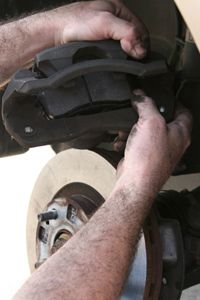Installing New Brake Pads
It's nearly time to install the new brake pads. But there's one more step to complete before you can do that. You have to manually retract the caliper piston.
If you look at the inside of the caliper you'll see a cylindrical piston coming out -- this part pushes on the inboard side of the brake pad. You'll see that it has adjusted itself to match your worn-out pads, so you'll need to reset the piston to its original position before the caliper, along with your new (and thicker) brake pads, will fit over the rotor.
Advertisement
Before you reset the caliper piston, it's a good idea to remove the cap that covers the brake fluid reservoir. If you don't, you'll be fighting against a significant amount of brake fluid pressure.
Now that the reservoir cap is removed, this is the part where you'll need that C-clamp. Place the end with the screw on it against the piston. You can use a small piece of wood to protect the surface of the piston, if you choose. As you turn the screw, the clamp will increase the pressure on the piston. Keep tightening it until you're able to slip the new pads into the caliper and fit the caliper and the new pads over the brake rotor.
If you find that the piston isn't properly retracting, don't force it. You may have a caliper that's been designed with a piston that slowly turns as it extends. If that's the case, then you'll need a special tool to thread the piston back into the caliper. A brake caliper tool -- a tool specifically designed to retract this type of brake caliper piston -- is available for purchase at most auto parts stores. If you can't find one there, then you can order the tool online -- or if you're really lucky, maybe your neighbor will have one that you can borrow for the afternoon.
Once the brake caliper piston has been fully retracted, you can re-cap the brake fluid reservoir. It's not a good idea to leave the cap off of your brake fluid reservoir for any longer than is absolutely necessary. Debris or even water may find its way into your brake's hydraulic system. Brake fluid is hygroscopic, which means that it absorbs and retains water. Water in the brake lines leads to serious safety concerns and more complex repairs than the relatively simple pad replacement that you're finishing up with right now.
Installing the new brake pads themselves is just a simple matter of slipping the new pads into the slots where you found the old ones. If they don't easily fit in with your hands, you may want to tap them in gently with a hammer or rubber mallet. Then, replace the pins or bolts that held them in place and you're nearly done.
Next, move the caliper back into position on the brake rotor. Make sure it fits snugly, and tighten the bolts that hold the caliper in place. Make sure everything is back in place and then give the brake pedal a few pumps from inside your car just to make sure the pedal feels right to you. It may take several pumps of the pedal to get the brakes to properly seat themselves into their new position.
The rest of the brake repair is easy. Put the wheel back on, tighten the lug nuts, remove the jack stands and lower the car to the ground using your jack. It's just like changing a tire. Remember to fully tighten (and properly torque) the lug nuts once you have the vehicle back on the ground.
Also, don't forget to test drive the car to make sure that your brake work was successful. Fixing brakes is one thing; making sure they work properly is another.
For more information about braking and other related topics, follow the links below. They'll provide you with lots more information.
Related Articles
More Great Links
More Great Links
Sources
- Blocker, Mark. "How to Inspect Front Brake Pads." eHow.com. (Nov. 13, 2008) http://www.ehow.com/video_2260524_inspect-front-brake-pads.html
- Blocker, Mark. "How to Replace Front Brake Pads." eHow.com. (Nov. 13, 2008) http://www.ehow.com/video_2260516_tools-changing-front-brake-pads.html
- ExpertVillage.com. "Checking the Rotor, Caliper & Wear Indicator for Brake Pads." (Nov. 13, 2008) http://www.expertvillage.com/video/4691_disc-brake-pads-rotor-caliper-wear-indicator.htm
- Google Product Search. "Buy Brake Pads." (Nov. 13, 2008) http://www.google.com/products?q=buy+brake+pads&oe=utf-8&sa=N&lnk=next&start=10
- Memmer, Scott. "How To Change Your Brake Pads." Edmunds.com. (Nov. 13, 2008) http://www.edmunds.com/ownership/howto/articles/43787/article.html
- Nice, Karim. "How Disc Brakes Work." HowStuffWorks.com. Aug. 21, 2000. (Nov. 13, 2008) https://www.howstuffworks.com/disc-brake.htm
